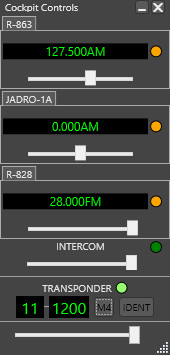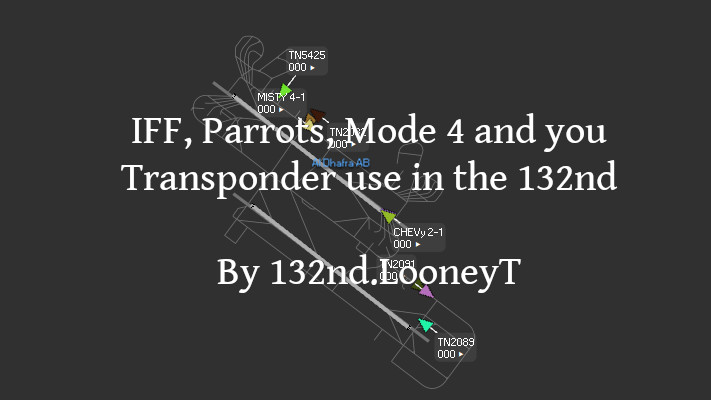The following article has been written by 132nd.LooneyT about the use of the Transponder in the 132nd Virtual Wing.
The original Google Drive file is available here.
IFF, parrots, mode 4 and you. Transponder use in the 132nd.
With the use of SRS within the wing, the ability was created to start using the Transponder in DCS and LOTATC.
This enables fast identification of aircrafts on the LOTATC radar screen and airport view, allowing a more efficient way of controlling as well as limiting the number of errors made by controllers.
SRS simulates mode 1, mode 3 and mode 4 IFF systems. Since LOTATC can “see” the altitude an aircraft is at, we can say that mode 3/A is also simulated.
Mode 1 provides a 2 digit, octal (numbers 0 – 7), “mission code” that can be used to identify the aircraft type or mission.
Mode 3/A provides as 4 digit octal identification code for the aircraft, assigned by the controller and is used to identify the aircraft itself.
Mode 4 is a 3 pulse reply, encrypted, based on an encrypted challenge made by a radar. It is most commonly used as an IFF system onboard radar-capable aircrafts to “challenge” a radar contact to see if the reply is correct. Usually, when the reply is incorrect, a contact is labelled something different to Friend such as Neutral or Hostile.
LOTATC is able to “read” mode 1 and 3/A codes and will display this information to a controller.
Remember, mode 4 is only used by a pilot in a radar capable aircraft equipped with a mode 4 interrogator in DCS. Aircrafts capable of making a mode 4 “challenge” are, amongst others, the F-16, F-18 and F-14.
This document serves to illustrate the use of the SRS radio overlay and DCS chat commands as well as showing the correct use of the IFF related brevity. Airframe specific description of the IFF equipment can be described in the squadron’s SOP or other document.

As we are using a mix of NATO and Non-NATO airframes within the 132nd, the use of mode 1 and 3 is globally provided by the SRS overlay. Aircrafts which are capable of using their onboard DCS IFF are the A10c, F14, F16, F5 and F14 with more to come at time of this writing.
All other units can use the SRS overlay to set their IFF codes! You can even power on, change and set the different transponder options using the DCS chat. We’ll get to that later.
SRS radio overlay

Power button: Click this red circle to power on the IFF transponder. It will show green once powered. Click again to switch off the IFF transponder.
Mode 1 code setting: Once powered on, you can set a 2-digit, octal (0 – 7) code in this window.
Mode 3 code setting: Once powered on, you can set a 4-digit, octal (0 – 7) code in this window.
Mode 4 On/Off: Switches On/Off the Mode 4 encrypted radar reply system. It will show green once powered On.
Ident switch: This toggles the IDENT function of a transponder. Once pressed it will turn green and the controller will show a red glowing box around the contact’s details, indicating it has pressed Ident. The Ident function as active for 40 seconds.
Window Opacity slider: Slider to set the opacity for the complete overlay.

Figure 3 shows a transponder set to operate, mode 1 code set to 11 and mode 3 code set to 1200. Remember, you must switch on the Transponder before you are able to set a mode 1 or mode 3 code. When powered OFF, the M4 and Ident switch will not work.
Pressing IDENT is usually done at the request of a controller. It helps the controller to quickly locate an aircraft in the clutter of the radar screen. Once pressed, LOTATC will display a contact as shown in figure 4, allowing it to be easily identified by the controller. After 40 seconds, the IDENT will stop automatically. Note, the 40 second timer may change in the future.

The M4 button is used to set the IFF to the coalition you are currently in. Presently, the IFF in DCS is coalition based so anyone will show up as Friend once M4 is active and you are being interrogated by another friendly pilot.
Note that the M4 button is only used to indicate to LOTATC which coalition you are in.
DCS Chat transponder setting
In order to allow (VR) pilots to set their transponder quick and easy, SRS can be activated using the DCS chat.
Simply use the LEFT-SHIFT TAB key combination to bring up the DCs chat window in game. Now, a selection of commands are available to fully control the SRS transponder.
All commands are preceded by SRSTRANS. A list of all available commands is listed below.

Transponder / IFF Panel Chat Commands
Type in chat (local or global)
SRSTRANS e.g. SRSTRANS POWER:ON or SRSTRANS POWER ON
Commands can be chained so you can do SRSTRANS M3 7777 M1 12 M4 ON IDENT ON to set mode 3 to 7777, mode 1 to 12, mode 4 to on and Ident to on.
Complete list is;
M4 OFF or ON
M3 OFF or a 4 digit number
M1 OFF or a 2 digit number
IDENT OFF or ON
POWER OFF or ON
Brevity and Communications
With a new function comes new brevity and abbreviations. Within the 132nd the following brevity words are used for use with a transponder;
Parrot – IFF equipment
Squawk Code – Set your IFF to a certain code
Squawk Ident – Press Ident button on your transponder panel or use SRS overlay
Squawking – Informative call that indicates the sender is responding with a certain code or Ident
Sweet – Equipment is working correctly
Sour – Equipment is broken or malfunctioning
The communication for the correct use of the IFF transponder is usually started by a controller, all numbers are spoken as separate numerals. 3412 is spoken as Three Four One Two.
Viper1-1 this is Kutaisi ground, squawk 3412.
Kutaisi ground this is Viper1-1, squawking 3412
It is not uncommon for pilots to set their IFF up before contacting a controlling authority and stating they’ve set their codes to a certain number;
Kutaisi ground this is Axe2-1 with information Delta on board, squawking 4412
Axe2-1 this is Kutaisi ground, parrot sweet, information Delta is correct…
If a flight is calling in that has multiple aircrafts in it, in this case Falcon flight of 4 times F-16s, a controller may state the following;
Falcon4-1 this is Darkstar, squawk 4401 in sequence
This means that Falcon4-1 will squawk 4401, Falcon4-2 will squawk 4402, 4-3 uses code 4403 and lastly Falcon4-4 will squawk 4404.
If a mode 1 needs to be set, the call is as follows;
Viper1-1 this is Darkstar, squawk mode 1, 14
Darkstar this is Viper1-1, squawking mode 1, 14
If a mode 1 (code 14) and mode 3 (code 4501) needs to be set, the call is as follows;
Viper1-1 this is Darkstar, squawk 14 4501
Darkstar this is Viper1-1, squawking 14 4501
Ident is requested as follows;
Falcon4-1 this is Kutaisi tower, squawk Ident
Kutaisi tower this is Falcon4-1, squawking Ident
If a pilot reports a code but it is not showing up in LOTATC, the controller will inform the pilot using the sour brevity.
Falcon4-1 this is Tower, your parrot sour
Falcon4-1 now checks his equipment and remedies the situation, now he is squawking correctly.
Falcon4-1 this is Tower, your parrot now sweet
Any flight can declare their IFF equipment not functioning by making the informative call to a controlling agency;
Darkstar this is Axe2-1, my parrot sour
Special codes
Within the aviation world, there are a couple of mode 3/A codes that are used in special cases. These codes are:
| Transponder code | Allocated use |
| 7000 | VFR standard squawk code when no other code has been assigned |
| 7600 | Lost communications (NOCOMMS), radio failure |
| 7700 | General emergency |
| 7777 | Interceptor aircraft on active air-defense missions and operating without ATC clearance, e.g. Scramble mission |
Use of these codes is at pilot’s discretion and can be set at any time (except 7777), regardless of what a controller told a pilot to set. These codes will indicate to a controller that something is wrong, except for 7000/7777. Squawking 7700 will also make you glow red on the LOTATC screen so be prepared to answer questions from the controller.
Two codes that are not allowed to be set are:
| Transponder code | Allocated use |
| 7500 | Hijack or unlawful interference |
| 0000 | Non-discrete code, standard LOTATC code for any contact, hence completely unuseful. |
When you set your transponder code, care must be taken not to set any emergency code during a code change!
For example, when changing from 0500 to 7000 (VFR code); you might set your first digit to a 7 (thus squawking 7500) and at this time, set your second digit back to zero. However, since you’ve set 7500 in the meantime, you will draw a lot of attention to yourself by doing this.
The recommended method to changing code is to first set your transponder to standby or off (in case of in aircraft equipment) or use the DCS chat SRSTRANS method to set a code directly or switch it off in the overlay first.
Mode 1 codes will only be given at the discretion of the mission designer, AMC or controller if it helps to keep things organized. Check the ATO or event page to make sure you set the correct code or hand out the correct code in case of being a controller.
